Identification and Expression Analysis of Chemosensory Genes in the Antennal Transcriptome of Chrysanthemum Aphid Macrosiphoniella sanborni
Abstract
:Simple Summary
Abstract
1. Introduction
2. Materials and Methods
2.1. Ethics Statement
2.2. Aphid Rearing and Tissue Collection
2.3. cDNA Library Construction and Illumina Sequencing
2.4. De Novo Assembly
2.5. Identification of Chemosensory Genes
2.6. Sequence and Phylogenetic Analysis
2.7. Differentially Expressed Unigene Analysis
2.8. Expression Analysis with qRT-PCR
3. Results
3.1. Antennal Transcriptome Sequencing and Sequence Assembly
3.2. Functional Annotation
3.3. Candidate OBPs
3.4. Candidate CSPs
3.5. Candidate ORs
3.6. Candidate IRs
3.7. Candidate SNMPs
3.8. Differentially Expressed Gene (DEG) Analysis of Candidate Chemosensory Genes
3.9. Odor- and Wing-Specific Expression of Candidate Chemosensory Genes
4. Discussion
5. Conclusions
Supplementary Materials
Author Contributions
Funding
Institutional Review Board Statement
Data Availability Statement
Acknowledgments
Conflicts of Interest
References
- Jensen, A.S.; Barjadze, S.; Kanturski, M. A review of the aphid genus Macrosiphoniella del Guercio, 1911 (Hemiptera: Aphididae) in the USA with description of a new species. Eur. Zool. J. 2020, 87, 412–443. [Google Scholar] [CrossRef]
- Hu, H.; Li, J.; Delatte, T.; Vervoort, J.; Gao, L.; Verstappen, F.; Xiong, W.; Gan, J.; Jongsma, M.A.; Wang, C. Modification of chrysanthemum odour and taste with chrysanthemol synthase induces strong dual resistance against cotton aphids. Plant Biotechnol. J. 2018, 16, 1434–1445. [Google Scholar] [CrossRef] [PubMed] [Green Version]
- Yang, B.; Liu, Y.; Wang, B.; Wang, G. Olfaction-based Behaviorally Manipulated Technology of Pest Insects Research Progress, Opportunities and Challenges. Bull. Nat. Nat. Sci. Found. Chin. 2020, 34, 441–446. [Google Scholar] [CrossRef]
- Ninkovic, V.; Markovic, D.; Rensing, M. Plant volatiles as cues and signals in plant communication. Plant Cell Environ. 2021, 44, 1030–1043. [Google Scholar] [CrossRef]
- Eunho, S.; Jonathan, D.B.; Laurence, J.Z. Peripheral olfactory signaling in insects. Curr. Opin. Insect Sci. 2014, 6, 86–92. [Google Scholar] [CrossRef] [Green Version]
- Gu, S.; Wu, K.; Guo, Y.; Field, L.M.; Pickett, J.A.; Zhang, Y.; Zhou, J.; Wilkinson, T.L. Identification and Expression Profiling of Odorant Binding Proteins and Chemosensory Proteins between Two Wingless Morphs and a Winged Morph of the Cotton Aphid Aphis gossypii Glover. PLoS ONE 2013, 8, e73524. [Google Scholar] [CrossRef] [Green Version]
- Xue, W.; Fan, J.; Zhang, Y.; Xu, Q.; Han, Z.; Sun, J.; Chen, J. Identification and Expression Analysis of Candidate Odorant-Binding Protein and Chemosensory Protein Genes by Antennal Transcriptome of Sitobion avenae. PLoS ONE 2016, 11, e161839. [Google Scholar] [CrossRef]
- Kang, Z.W.; Liu, F.H.; Pang, R.P.; Yu, W.B.; Tan, X.L.; Zheng, Z.Q.; Tian, H.G.; Liu, T.X. The identification and expression analysis of candidate chemosensory genes in the bird cherry-oat aphid Rhopalosiphum padi (L.). Bull. Entomol. Res. 2018, 108, 645–657. [Google Scholar] [CrossRef]
- Purandare, S.R.; Brisson, J.A. Divergent chemosensory gene expression accompanies ecological specialisation of pea aphid morphs. Ecol. Entomol. 2019, 45, 364–368. [Google Scholar] [CrossRef]
- Zhou, J.J.; Vieira, F.G.; He, X.L.; Smadja, C.; Liu, R.; Rozas, J.; Field, L.M. Genome annotation and comparative analyses of the odorant-binding proteins and chemosensory proteins in the pea aphid Acyrthosiphon pisum. Insect Mol. Biol. 2010, 19, 113–122. [Google Scholar] [CrossRef] [Green Version]
- Quan, Q.; Hu, X.; Pan, B.; Zeng, B.; Wu, N.; Fang, G.; Cao, Y.; Chen, X.; Li, X.; Huang, Y.; et al. Draft genome of the cotton aphid Aphis gossypii. Insect Biochem. Mol. Biol. 2019, 105, 25–32. [Google Scholar] [CrossRef]
- Bai, P.; Wang, B.; Zhang, X.; Wang, G. Research methods and advances of odorant receptors in insects. Acta Entomol. Sin. 2022, 65, 364–385. [Google Scholar] [CrossRef]
- Zhang, R.; Wang, B.; Grossi, G.; Falabella, P.; Liu, Y.; Yan, S.; Lu, J.; Xi, J.; Wang, G. Molecular Basis of Alarm Pheromone Detection in Aphids. Curr. Biol. 2017, 27, 55–61. [Google Scholar] [CrossRef] [Green Version]
- Qin, Y.G.; Yang, Z.K.; Song, D.L.; Wang, Q.; Gu, S.H.; Li, W.H.; Duan, H.X.; Zhou, J.J.; Yang, X.L. Bioactivities of synthetic salicylate-substituted carboxyl (E)-β-Farnesene derivatives as ecofriendly agrochemicals and their binding mechanism with potential targets in aphid olfactory system. Pest Manag. Sci. 2020, 76, 2465–2472. [Google Scholar] [CrossRef]
- Wang, Q.; Liu, J.; Zhang, Y.; Chen, J.; Li, X.; Liang, P.; Gao, X.; Zhou, J.; Gu, S. Coordinative mediation of the response to alarm pheromones by three odorant binding proteins in the green peach aphid Myzus persicae. Insect Biochem. Mol. Biol. 2021, 130, 103528. [Google Scholar] [CrossRef]
- Ullah, R.M.K.; Quershi, S.R.; Adeel, M.M.; Abdelnabby, H.; Waris, M.I.; Duan, S.; Wang, M. An Odorant Binding Protein (SaveOBP9) Involved in Chemoreception of the Wheat Aphid Sitobion avenae. Int. J. Mol. Sci. 2020, 21, 8331. [Google Scholar] [CrossRef]
- Onofrio, C.D.; Knoll, W.; Pelosi, P. Aphid Odorant-Binding Protein 9 Is Narrowly Tuned to Linear Alcohols and Aldehydes of Sixteen Carbon Atoms. Insects 2021, 12, 741. [Google Scholar] [CrossRef]
- Peng, X.; Liu, L.; Huang, Y.X.; Wang, S.J.; Li, D.X.; Chen, S.T.; Simon, J.C.; Qu, M.J.; Chen, M.H. Involvement of chemosensory proteins in host plant searching in the bird cherry-oat aphid. Insect Sci. 2021, 28, 1338–1353. [Google Scholar] [CrossRef]
- Huang, T.; Zhang, R.; Yang, L.; Cao, S.; Francis, F.; Wang, B.; Wang, G. Identification and functional characterization of ApisOr23 in pea aphid Acyrthosiphon pisum. J. Integr. Agric. 2022, 21, 1414–1423. [Google Scholar] [CrossRef]
- Zhong, J.; Guo, Y.; Xu, T.; Li, D.; Zhang, Q.; Sun, M. Observation on the morphological characteristics for age identification of Macrosiphoniella sanborni (Hemiptera: Aphididae) and the ultrastructure of its antennal sensilla. Acta Entomol. Sin. 2019, 62, 1315–1324. [Google Scholar] [CrossRef]
- Vellichirammal, N.N.; Madayiputhiya, N.; Brisson, J.A. The genomewide transcriptional response underlying the pea aphid wing polyphenism. Mol. Ecol. 2016, 25, 4146–4160. [Google Scholar] [CrossRef] [PubMed] [Green Version]
- Song, L.; Gao, Y.; Li, J.; Ban, L. iTRAQ-Based Comparative Proteomic Analysis Reveals Molecular Mechanisms Underlying Wing Dimorphism of the Pea Aphid, Acyrthosiphon pisum. Front. Physiol. 2018, 9, 1016. [Google Scholar] [CrossRef] [PubMed]
- Martin, M. Cutadapt removes adapter sequences from high-throughput sequencing reads. EMBnet J. 2011, 17, 10–12. [Google Scholar] [CrossRef]
- Grabherr, M.G.; Haas, B.J.; Yassour, M.; Levin, J.Z.; Thompson, D.A.; Amit, I.; Adiconis, X.; Fan, L.; Raychowdhury, R.; Zeng, Q.; et al. Full-length transcriptome assembly from RNA-Seq data without a reference genome. Nat. Biotechnol. 2011, 29, 644–652. [Google Scholar] [CrossRef] [Green Version]
- Buchfink, B.; Xie, C.; Huson, D.H. Fast and sensitive protein alignment using DIAMOND. Nat. Methods 2015, 12, 59–60. [Google Scholar] [CrossRef]
- Kumar, S.; Stecher, G.; Li, M.; Knyaz, C.; Tamura, K.; Battistuzzi, F.U. MEGA X: Molecular Evolutionary Genetics Analysis across Computing Platforms. Mol. Biol. Evol. 2018, 35, 1547–1549. [Google Scholar] [CrossRef]
- Patro, R.; Duggal, G.; Love, M.I.; Irizarry, R.A.; Kingsford, C. Salmon provides fast and bias-aware quantification of transcript expression. Nat. Methods 2017, 14, 417–419. [Google Scholar] [CrossRef] [Green Version]
- Mortazavi, A.; Williams, B.A.; McCue, K.; Schaeffer, L.; Wold, B. Mapping and quantifying mammalian transcriptomes by RNA-Seq. Nat. Methods 2008, 5, 621–628. [Google Scholar] [CrossRef]
- Robinson, M.D.; McCarthy, D.J.; Smyth, G.K. edgeR: A Bioconductor package for differential expression analysis of digital gene expression data. Bioinformatics 2009, 26, 139–140. [Google Scholar] [CrossRef] [Green Version]
- Wang, Q.; Zhou, J.J.; Liu, J.T.; Huang, G.Z.; Xu, W.Y.; Zhang, Q.; Chen, J.L.; Zhang, Y.J.; Li, X.C.; Gu, S.H. Integrative transcriptomic and genomic analysis of odorant binding proteins and chemosensory proteins in aphids. Insect Mol. Biol. 2019, 28, 1–22. [Google Scholar] [CrossRef]
- Liu, J.; Wang, Q.; Zhao, R.; Wang, H.; Gao, J.; Dong, H.; Zhang, Y.; Cong, B.; Gu, S. Identification, expression and binding specificity of chemosensory proteins in the antennal transcriptome of the pea aphid, Acyrthosiphon pisum (Hemiptera: Aphididae). Acta Entomol. Sin. 2022, 65, 261–270. [Google Scholar] [CrossRef]
- Cao, D.; Liu, Y.; Walker, W.B.; Li, J.; Wang, G. Molecular characterization of the Aphis gossypii olfactory receptor gene families. PLoS ONE 2014, 9, e101187. [Google Scholar] [CrossRef]
- Robertson, H.M.; Robertson, E.C.N.; Walden, K.K.O.; Enders, L.S.; Miller, N.J. The chemoreceptors and odorant binding proteins of the soybean and pea aphids. Insect Biochem. Mol. Biol. 2019, 105, 69–78. [Google Scholar] [CrossRef]
- Benton, R.; Vannice, K.S.; Gomez-Diaz, C.; Vosshall, L.B. Variant ionotropic glutamate receptors as chemosensory receptors in Drosophila. Cell 2009, 136, 149–162. [Google Scholar] [CrossRef] [Green Version]
- Wicher, D. Tuning Insect Odorant Receptors. Front. Cell. Neurosci. 2018, 12, 94. [Google Scholar] [CrossRef] [Green Version]
- Ni, L.; Klein, M.; Svec, K.V.; Budelli, G.; Chang, E.C.; Ferrer, A.J.; Benton, R.; Samuel, A.D.; Garrity, P.A. The Ionotropic Receptors IR21a and IR25a mediate cool sensing in Drosophila. eLife 2016, 5, 13254. [Google Scholar] [CrossRef]
- Knecht, Z.A.; Silbering, A.F.; Ni, L.; Klein, M.; Budelli, G.; Bell, R.; Abuin, L.; Ferrer, A.J.; Samuel, A.D.; Benton, R.; et al. Distinct combinations of variant ionotropic glutamate receptors mediate thermosensation and hygrosensation in Drosophila. eLife 2016, 5, 17879. [Google Scholar] [CrossRef]
- Agnihotri, A.R.; Roy, A.A.; Joshi, R.S. Gustatory receptors in Lepidoptera: Chemosensation and beyond. Insect Mol. Biol. 2016, 25, 519–529. [Google Scholar] [CrossRef] [Green Version]
- Liu, S.; Zhang, Y.; Zhou, W.; Liang, Q.; Yuan, X.; Cheng, J.; Zhu, Z.; Gong, Z. Identification and characterization of two sensory neuron membrane proteins from Cnaphalocrocis medinalis (Lepidoptera: Pyralidae). Arch. Insect Biochem. 2013, 82, 29–42. [Google Scholar] [CrossRef]
- Brito, N.F.; Moreira, M.F.; Melo, A.C. A look inside odorant-binding proteins in insect chemoreception. J. Insect Physiol. 2016, 95, 51–65. [Google Scholar] [CrossRef]
- Xu, Y.; He, P.; Zhang, L.; Fang, S.; Dong, S.; Zhang, Y.; Li, F. Large-scale identification of odorant-binding proteins and chemosensory proteins from expressed sequence tags in insects. BMC Genom. 2009, 10, 632. [Google Scholar] [CrossRef] [Green Version]
- Wanner, K.W.; Willis, L.G.; Theilmann, D.A.; Isman, M.B.; Feng, Q.; Plettner, E. Analysis of the insect os-d-like gene family. J. Chem. Ecol. 2004, 30, 889–911. [Google Scholar] [CrossRef]
- Fleischer, J.; Pregitzer, P.; Breer, H.; Krieger, J. Access to the odor world: Olfactory receptors and their role for signal transduction in insects. Cell. Mol. Life Sci. 2017, 75, 485–508. [Google Scholar] [CrossRef]
- Yang, H.; Dong, J.; Sun, Y.; Hu, Z.; Lyu, Q.; Li, D. Identification and expression profiles of candidate chemosensory receptors in Histia rhodope (Lepidoptera: Zygaenidae). PeerJ 2020, 8, e10085. [Google Scholar] [CrossRef]
- Liu, N.; Xu, W.; Dong, S.; Zhu, J.; Xu, Y.; Anderson, A. Genome-wide analysis of ionotropic receptor gene repertoire in Lepidoptera with an emphasis on its functions of Helicoverpa armigera. Insect Biochem. Mol. Biol. 2018, 99, 37–53. [Google Scholar] [CrossRef] [Green Version]
- Zhang, F.; Zhang, Z. Comparative study on the antennal sensilla of various forms of Myzus persicae. Acta Entomol. Sin. 2000, 43, 131–136. [Google Scholar] [CrossRef]
- Zhang, F.; Li, X.; Zhang, Y.; Cheng, D. Morphological examination of winged and wingless forms of the grain aphid Sitobion miscanthi. Plant Prot. 2015, 41, 56–62. [Google Scholar]
- Shao, S.X.; Yang, Z.X.; Chen, H.; Wang, C.; Wu, H.X.; Jiang, B.; Chen, X.M. Comparison and analysis of the antennal sensilla of morphs of the aphid Schlechtendalia chinensis (Bell) (Hemiptera: Pemphigidae). J. Environ. Entomol. 2020, 42, 1510–1517. [Google Scholar]
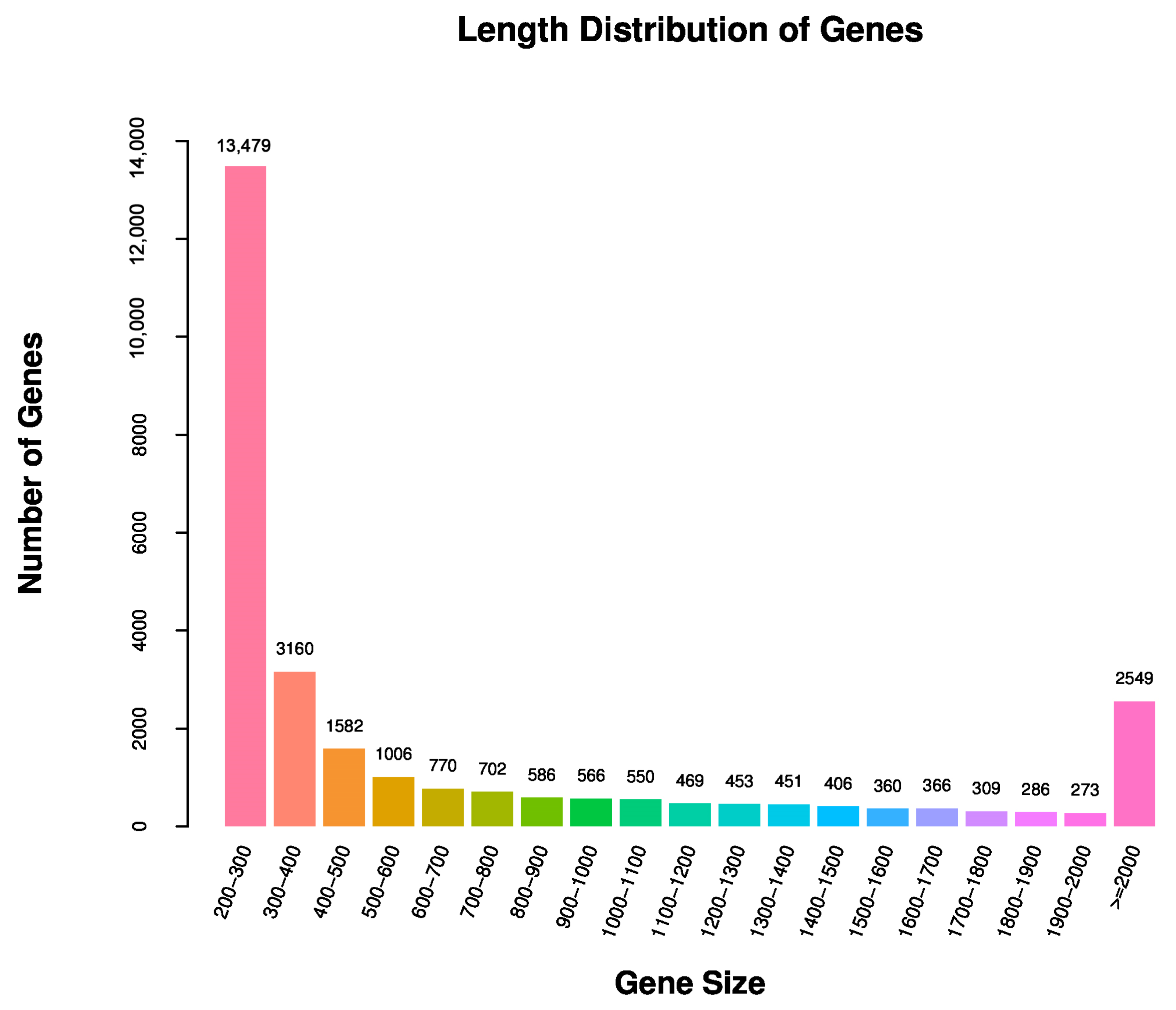
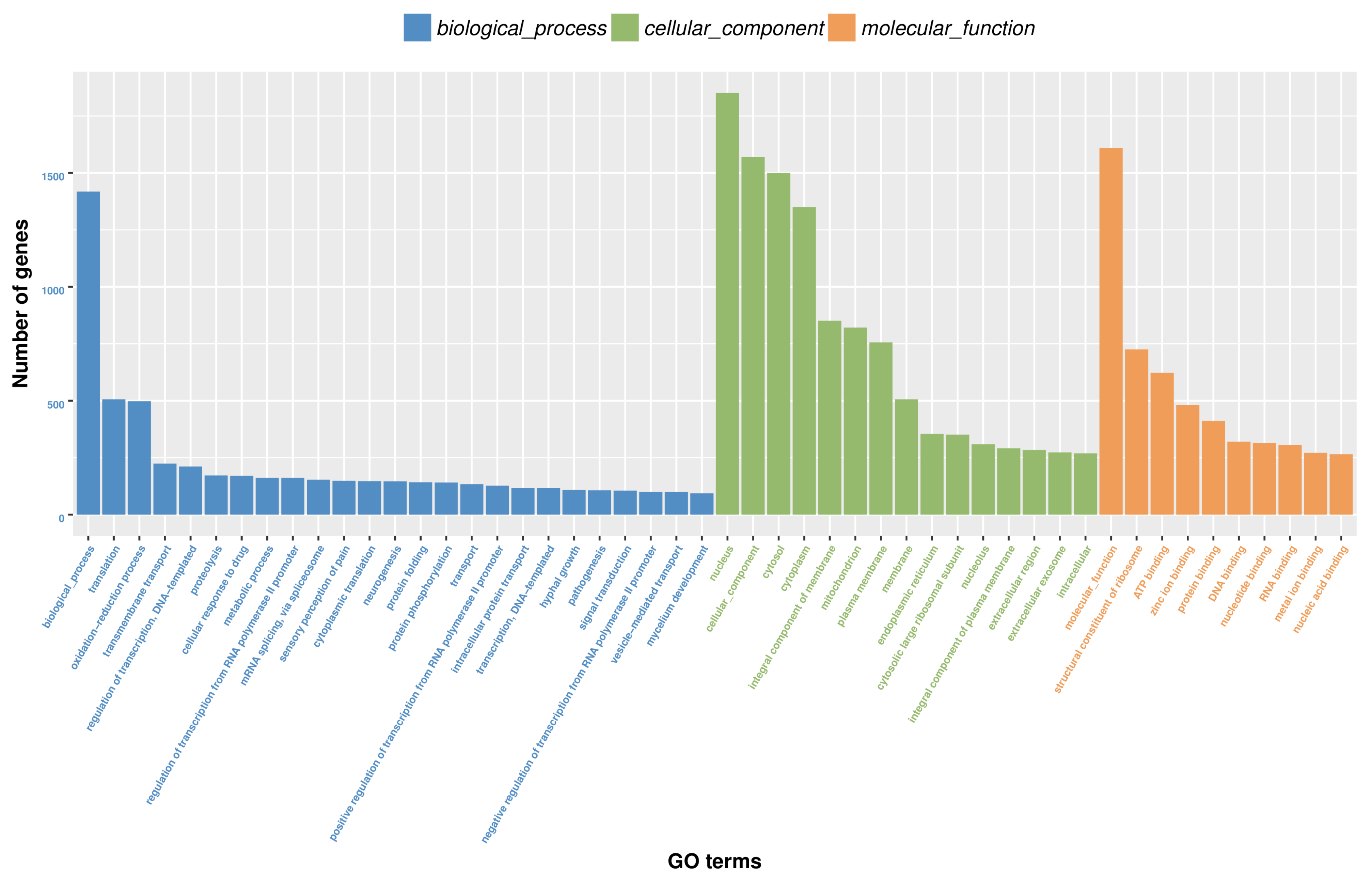

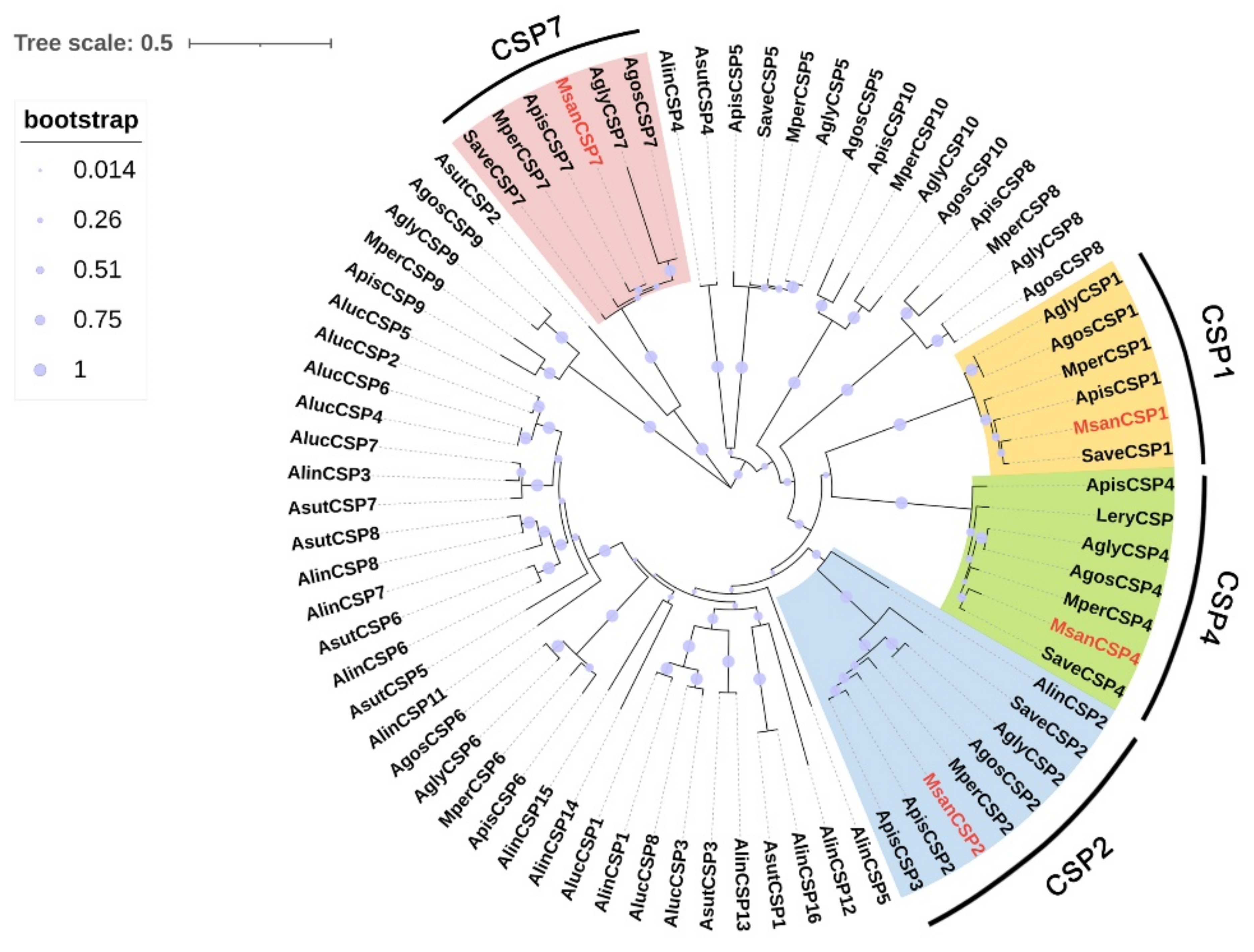
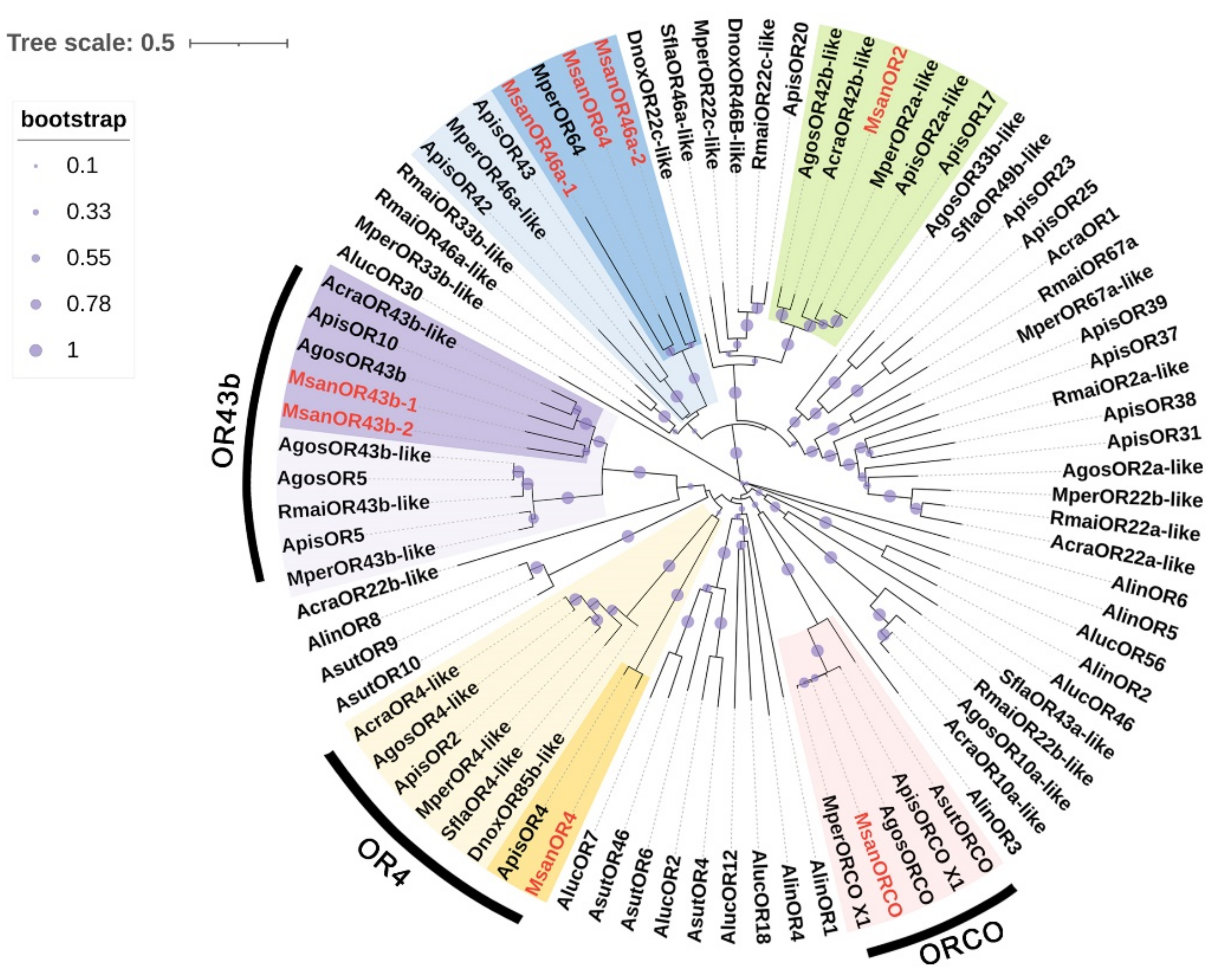
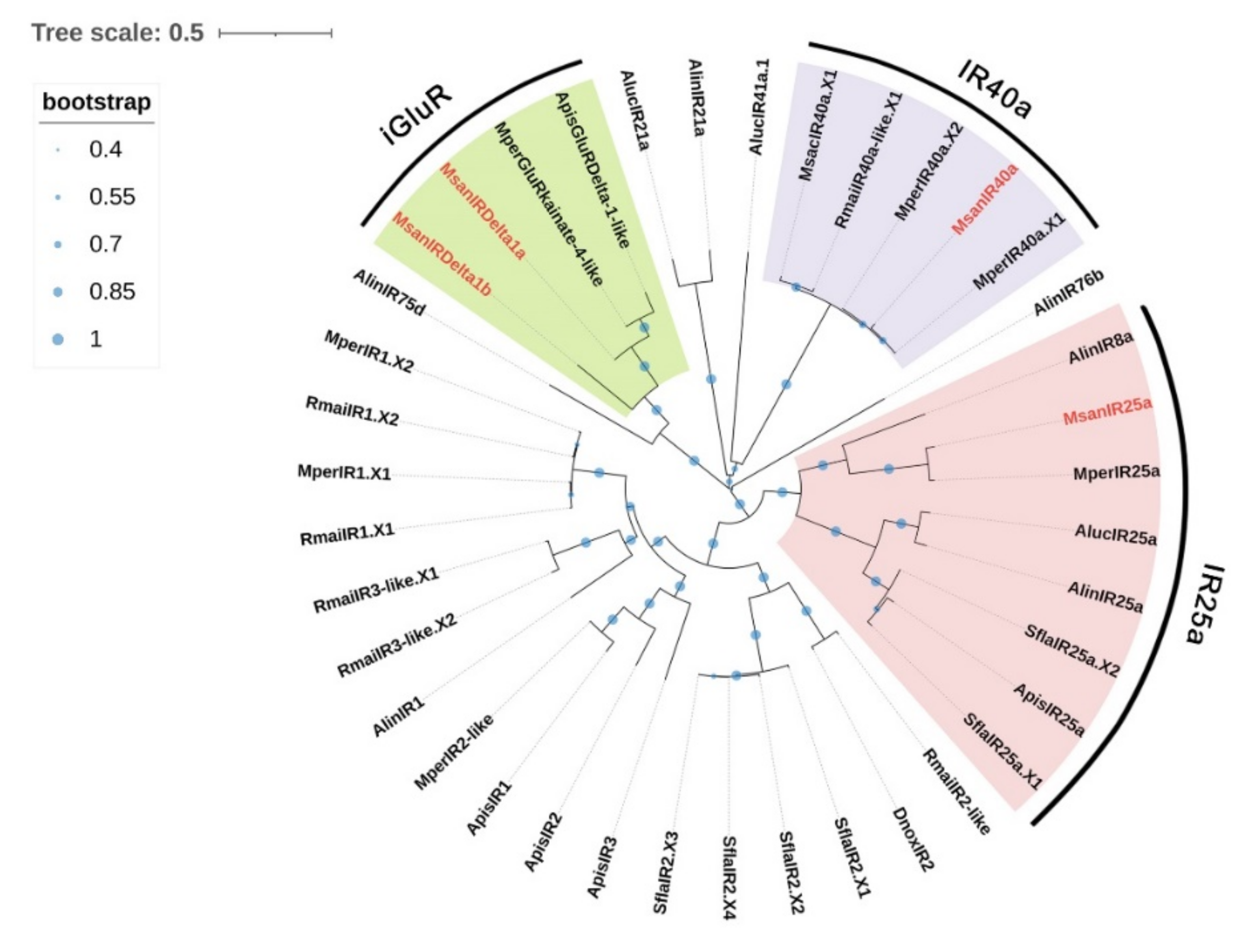
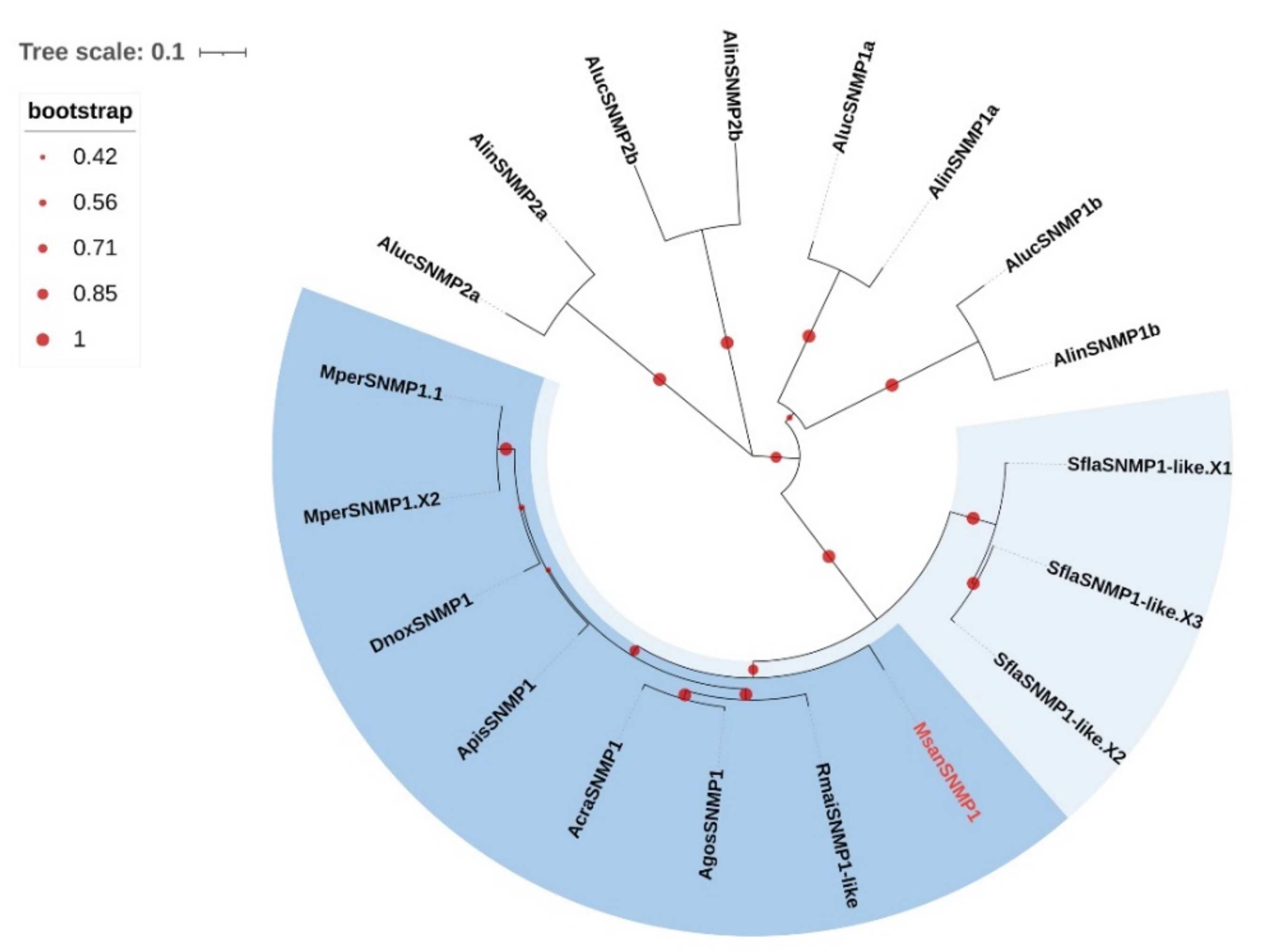
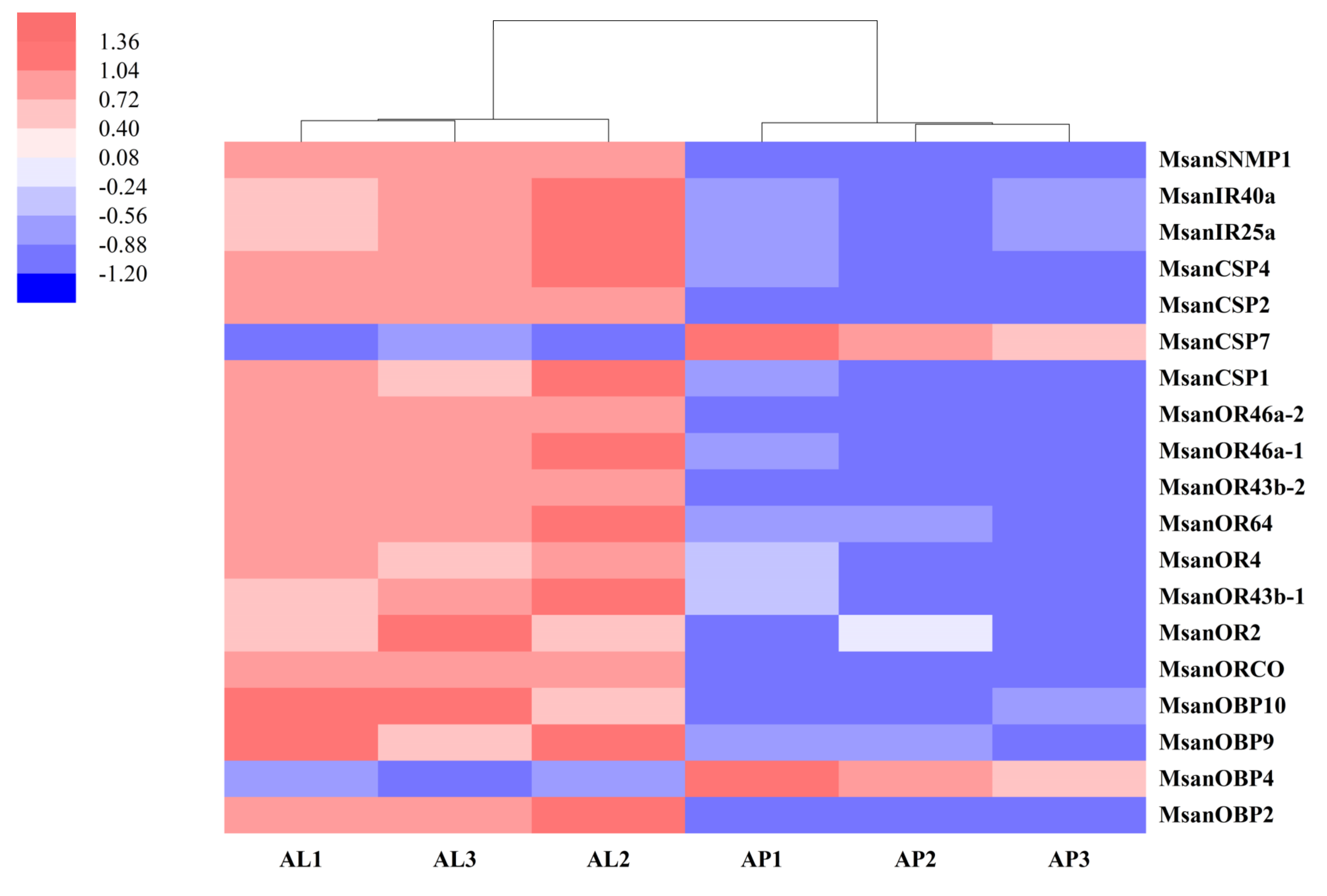
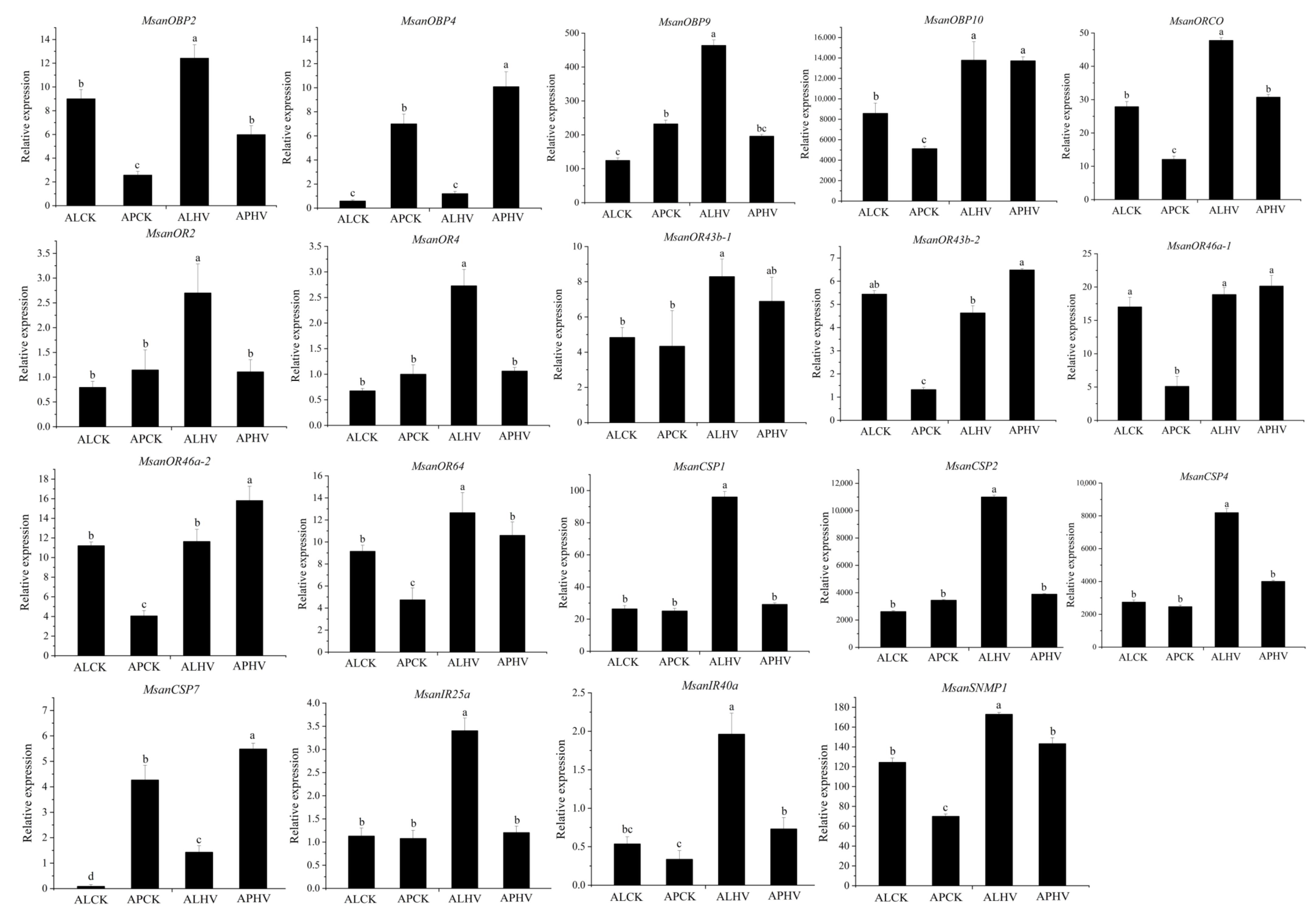
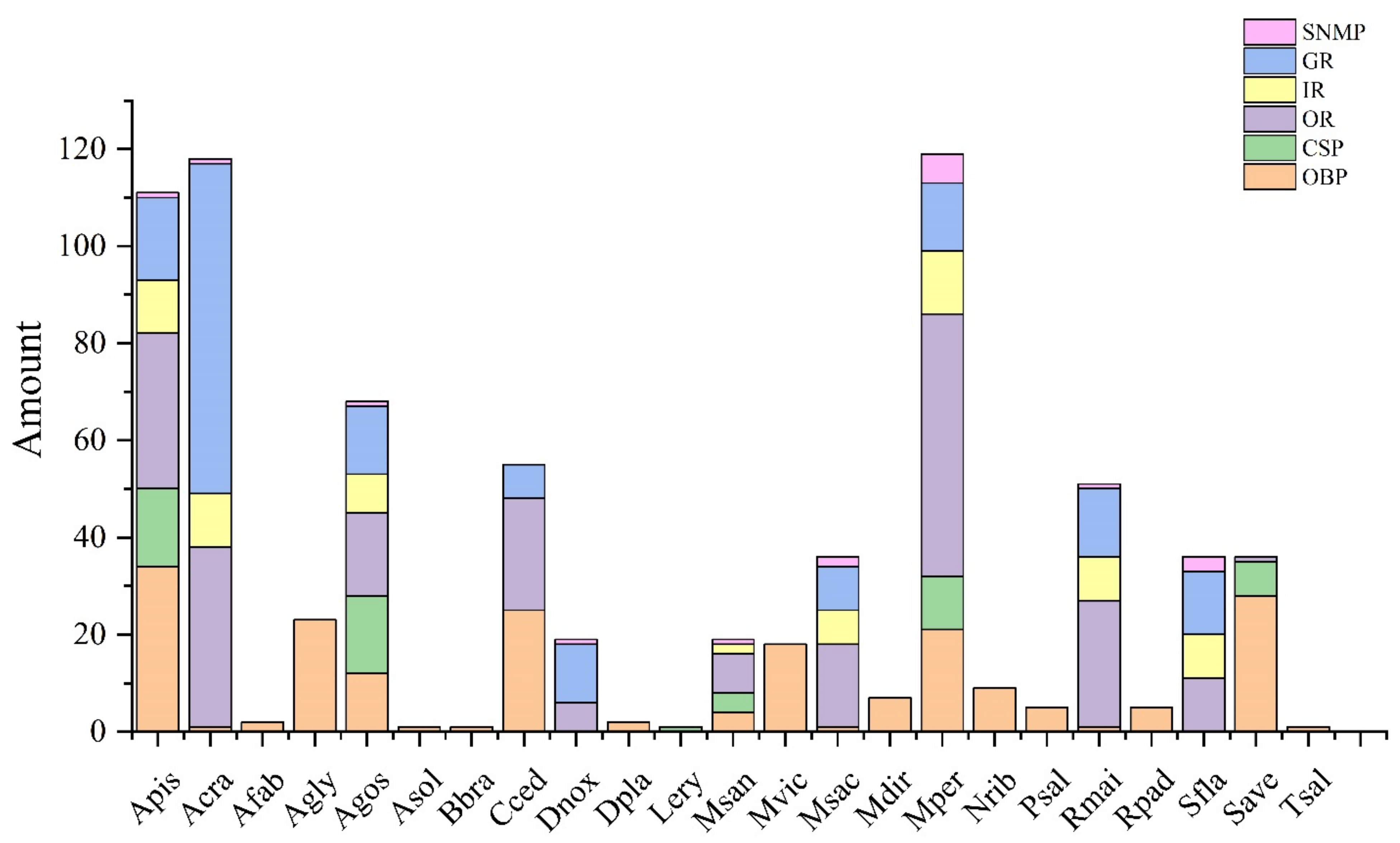
Publisher’s Note: MDPI stays neutral with regard to jurisdictional claims in published maps and institutional affiliations. |
© 2022 by the authors. Licensee MDPI, Basel, Switzerland. This article is an open access article distributed under the terms and conditions of the Creative Commons Attribution (CC BY) license (https://creativecommons.org/licenses/by/4.0/).
Share and Cite
Zhong, J.; Wang, Y.; Lu, Y.; Ma, X.; Zhang, Q.; Wang, X.; Zhang, Q.; Sun, M. Identification and Expression Analysis of Chemosensory Genes in the Antennal Transcriptome of Chrysanthemum Aphid Macrosiphoniella sanborni. Insects 2022, 13, 597. https://doi.org/10.3390/insects13070597
Zhong J, Wang Y, Lu Y, Ma X, Zhang Q, Wang X, Zhang Q, Sun M. Identification and Expression Analysis of Chemosensory Genes in the Antennal Transcriptome of Chrysanthemum Aphid Macrosiphoniella sanborni. Insects. 2022; 13(7):597. https://doi.org/10.3390/insects13070597
Chicago/Turabian StyleZhong, Jian, Yuxin Wang, Yufan Lu, Xiaoou Ma, Qian Zhang, Xiaoyue Wang, Qixiang Zhang, and Ming Sun. 2022. "Identification and Expression Analysis of Chemosensory Genes in the Antennal Transcriptome of Chrysanthemum Aphid Macrosiphoniella sanborni" Insects 13, no. 7: 597. https://doi.org/10.3390/insects13070597
APA StyleZhong, J., Wang, Y., Lu, Y., Ma, X., Zhang, Q., Wang, X., Zhang, Q., & Sun, M. (2022). Identification and Expression Analysis of Chemosensory Genes in the Antennal Transcriptome of Chrysanthemum Aphid Macrosiphoniella sanborni. Insects, 13(7), 597. https://doi.org/10.3390/insects13070597





